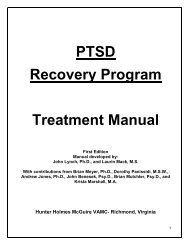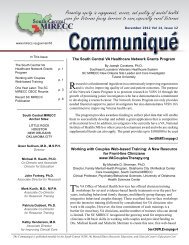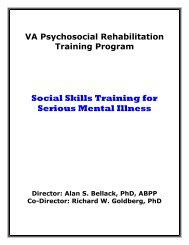Suicide Risk Assessment Package (VISN 3 MIRECC, US ...
Suicide Risk Assessment Package (VISN 3 MIRECC, US ...
Suicide Risk Assessment Package (VISN 3 MIRECC, US ...
Create successful ePaper yourself
Turn your PDF publications into a flip-book with our unique Google optimized e-Paper software.
This document may be used only with the permission of the <strong>VISN</strong> 3 <strong>Suicide</strong> Workgroup<br />
and the <strong>VISN</strong> 3 <strong>MIRECC</strong><br />
It is theoretically possible for a patient to be a suicide risk in the absence of any<br />
longstanding risk factors, but psychological autopsy data suggests that this is a very<br />
unlikely scenario.<br />
Previous <strong>Suicide</strong> Attempts: (describe circumstances, stressors and means of previous<br />
suicide attempts, in particular the details of the most recent attempt prior to the current<br />
one, including response to treatment interventions) free text required<br />
This is the single most significant actuarial factor in the prediction of suicidal behavior<br />
and suicide risk. The more severe and violent the suicide attempt the higher risk we<br />
assign to subsequent behavior. A suicide attempt is an action dangerous to oneself<br />
accompanied by an intent to die. It counts even if we, as professionals, do not consider<br />
the attempt to be medically lethal. While a significant number of completed suicides<br />
occur on the first attempt, suicide attempters do go on to become completers with<br />
relatively high frequency(1-5). Collecting the data about previous attempts is important<br />
both for assessment of risk and for treatment planning.<br />
An important element in treatment planning is to attempt to evaluate suicide attempts in<br />
terms of escape behaviors vs. operant behaviors. Escape behavior is the coupling of<br />
the suicide attempt to the need to end overwhelming pain from the symptoms and<br />
circumstances the patient is experiencing. Operant behavior is when the suicide attempt<br />
appears to be used to cause change or response in the environment. Frequently<br />
elements of both will appear, but they may lead to different interventions, and different<br />
attitudes amongst treating clinicians.<br />
There is an overlap between this section and the section on Personal <strong>Risk</strong> Factors<br />
below, since many individuals require a constellation of factors to become suicidal, and<br />
the particular set of symptoms and circumstances can be quite idiosyncratic.<br />
Impulsivity: Violence yes [ ] no [ ]<br />
Verbal Aggression yes [ ] no [ ]<br />
Head Injury yes [ ] no [ ]<br />
Smoking yes [ ] no [ ]<br />
Impulsive behaviors yes [ ] no [ ]<br />
Describe: free text required for positives<br />
[NO’s will be included in the note generated from template]<br />
Impulsivity can not be underestimated as a contributor to suicide risk (1-5). The<br />
impulsive/aggressive factor correlates with both acute and longer term risk (1). The<br />
above list is symptoms that correlate with impulsivity. Violence and verbal aggression<br />
(1-5), are the most significant on this list. Head injury is an actuarial factor associated<br />
with increased suicide risk, probably through its impact on impulsivity (1) and smoking is<br />
also a correlate (1), although it is possible that both of these affect impulsivity through<br />
alterations in serotonergic function. “Impulsive behaviors” is a broad category, which<br />
allows clinicians to assess impulsivity in variety of ways. The first is by diagnosis and<br />
behaviors. Cluster B personality disorder as well as substance abuse diagnoses<br />
correlate with impulsivity. Substance use is a sign of impulsivity, even if subthreshold for<br />
an abuse or dependence disorder. Gambling, bulimia, kleptomania are all impulse<br />
control disorders. Some sexual disorders, and paraphilias are another group of<br />
impulsive behaviors, which in and of themselves do not have a high correlation with<br />
suicidal behavior, but may be significant with the presence of other factors. Absence of<br />
all these factors does not prove absence of impulsivity, but is a fairly good<br />
approximation.<br />
The other method for looking at impulsivity is to use questions from an impulsivity<br />
scale, the most well accepted being Barrett’s. These scales generally ask questions<br />
about the immediate need to act, restlessness, blurting out, impatience, instant<br />
gratification versus the ability to think and assess consequences before acting, and<br />
ability to delay gratification.






